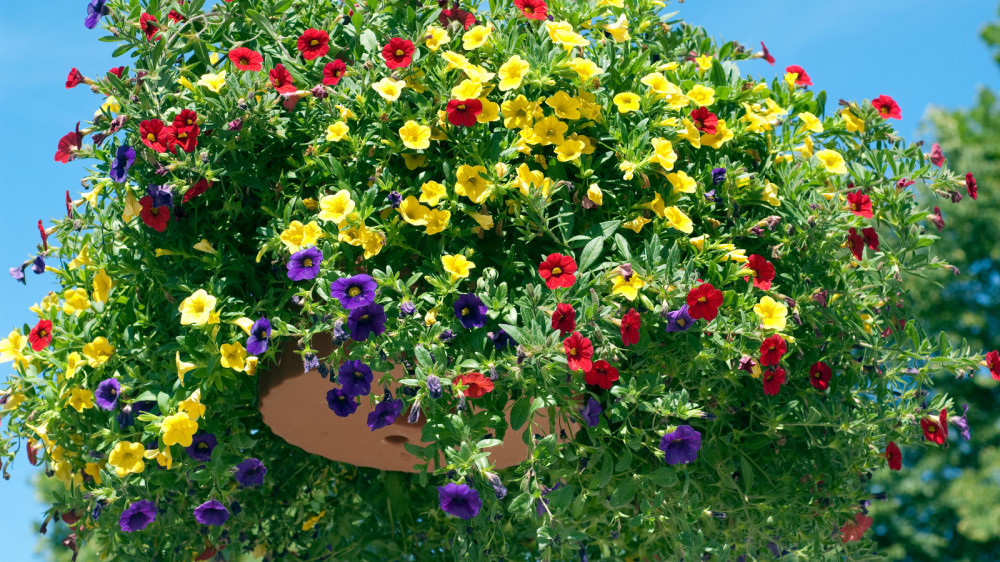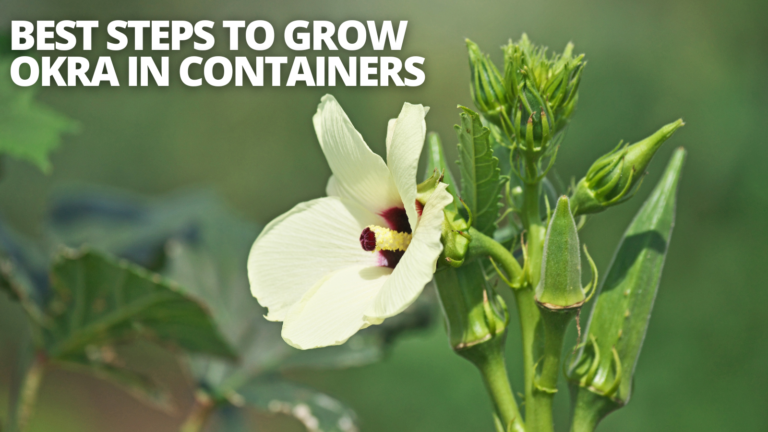Best Tips To Grow Million Bells Flowers In Containers
Best Tips To Grow Million Bells Flowers In Containers
Calibrachoa, often known as Million Bells, is a popular plant for growing outside containers.
Million Bells and Super Bells are trademarked names, even though they are often called Million Bells.
The plant is available in a wide range of hues. Million Bells blooms profusely, with 1-inch blossoms that resemble miniature petunias. The oval-shaped, compact leaves are a little sticky.
In most growing zones, a million bells are best planted or repotted in the spring. It can constantly bloom until the first frost and attracts butterflies and hummingbirds with its blossoms.
When cultivated as a container plant, it's also a rapid grower that swiftly reaches for the ground as a “spiller.”
It looks fantastic in hanging baskets, bowls, and mixed containers because of its trailing behaviour. It can also be used as a border plant in the ground.
Origin Of Million Bells Flowers
Million bells are completely cultivated plants with no natural origins. The lovely balcony flowers belong to the Solanaceae family and have their genus (Calibrachoa).
They were initially considered single genus because of their close kinship to petunias, but this has changed.
The rapid surge in popularity of micro petunias, which began in the 1990s, frightened experts that they might outperform the larger-flowered petunias.
Instead, they bloom peacefully beside one another, with new hues always blooming.
Growth
Million bells, like its bigger sister, petunias, have a sweeping, herby growth. Shoots can grow up to 20 inches long when hung.
Nonetheless, the plant's interior development is compact, resulting in a closed flower mat. Depending on the type, plants can be 16 to 24 inches tall and up to 12 inches wide.
Leaves And Flowers
The leaves of the Million Bell are dark green and elliptical. The stalks and foliage are slightly sticky.
The Million Bells' myriad tiny blossoms are cup-shaped and brightly coloured. Each year, the colour palette of the extraordinarily floral Million Bells expands.
Aside from the traditional pink, red, and yellow hues, white lemon-yellow kinds and brilliant orange create a stir and transmit Mediterranean flair.
The newest kinds, which feature two-tone blooms, colour mixes, and designs, are also popular, offering interesting combination options in pots, hanging baskets, and flower boxes.
A million bells blossom in a continuous, rich fullness until the fall.
Fruit
After flowering, the frutescences generate little green seed capsules, which become brown as they mature.
Types Of Million Bells Flowers
Now I’m showing some famous million bells verities. That will help you to grow Million Bells flowers in containers.

1. Minifamous Double Pink Million Bells
On a 10-inch-trailing plant, pink Calibrachoa produces double pink flowers. They look beautiful, and they are my favourites.

2. Pink Million Bells
The pink Calibrachoa bears vivid pink blooms on trailing stems up to 8 inches long.
3. Purple Million Bells
Calibrachoa Glow is a trailing variety that grows 8 inches tall and tolerates part shade. It reaches a width of 12 inches.
Here is another one of my favourite Million Bells kind of flowers. I love blue, and this type looks stunning among its pink cousins.
4. Minifamous Double Yellow Million Bells
On a strong plant that trails to 10 inches, yellow Calibrachoa bears exquisite double blossoms.
This is my third favourite Million Bells flower colour. They look so stunning together with the blue and pink versions.
5. Can-Can Mocha Million Bells
Creamy petals with a chocolate-purple throat characterize Mocha Calibrachoa. It grows 15 inches tall and wide, with a mounding-trailing habit.
6. Chocolate Million Bells
Chocolate' is a compact, mounding variety with burgundy blooms tinged with chocolate-brown that grows 8 inches tall.
7. MiniFamous Sun Violet Veins Million Bells
On a strong plant that trails to 10 inches, Veins Calibrachoa has beautiful blue blooms with violet-purple netting.
8. Terra Cotta Million Bells
Cotta Calibrachoa has orange flowers with red and gold streaks on trailing stems up to 8 inches long.
9. Coral Million Bells
Coral Calibrachoa has a lot of coral-pink flowers on 8-inch trailing stems.
10. Dark Red Million Bells
Dark Red MiniFamous Compact Calibrachoa is a trailing plant that produces rich red blossoms on a small 8-inch plant.
The dark red Million Bells plant is a regular in our flower garden. It looks so beautiful within our container garden's white and purple colours.
11. Minifamous Tangerine Million Bells
Tangerine Calibrachoa is a robust shrub with delicate yellow flowers with orange accents that trail to 8 inches.

12. Double Blue Million Bells
On a trailing plant with 10-inch-long stems, Blue Calibrachoa displays double velvety-blue blooms.
13. Minifamous Double Blush Million Bells
Blush Calibrachoa displays stunning double pink flowers on a strong trailing plant with 10-inch-long stems.
14. Superbells Blackberry Punch Million Bells
The ‘Superbells Blackberry Punch' blooms have a deep raspberry-red edge and a nearly black center.
15. Superbells Blue Million Bells
Calibrachoa Superbells Blue is a floriferous cultivar with masses of violet-blue flowers on 8-inch trailing stems.
Grow Million Bells Flowers In Containers
Soil
Use a good quality, well-draining, soilless potting mix in the containers. While it is unnecessary, adding compost to the soil before planting your Million Bells will benefit it.
Pot
It depends on the size of the plants and your hanging basket.
Suppose you're buying Million Bells flowers in 4″ pots, plant three in a 12″ pot as a general rule.
Make an equilateral triangle toward the pot's lovely and even center. Planting in groups of three creates a beautiful circle.
Light
The plant blooms best when it receives at least six hours of direct sunlight.
However, it can also handle partial shade, which is beneficial in hotter climates because plants that receive some shade are more likely to survive the summer months.
Blooming is often reduced when there is insufficient sun exposure.
Watering
Million Bells should be well hydrated but not drowned in water. Only add water once the top inch or two of soil has dried off.
Stick your finger into the dirt to the second knuckle to see if your plant needs water.
Water deeply till it seeps out of the bottom of your pot if the soil seems dry at your fingertip. Wait until the soil dries completely before watering again.
Heat, wind, and a lack of humidity can quickly dry up your soil. Depending on your circumstances, you may need to water twice a day.
Check the soil frequently, especially early in the season, until you understand your plant's requirements.
The watering requirements may change as the summer progresses. Avoid overwatering the plant, as this might lead to root rot.
Humidity & Temperature
The plant is drought, heat, and even cold tolerant, but don't let it dry out too much if you want perfect blossoms.
Temperatures between 55 and 65 degrees Fahrenheit are ideal for it. A hardened-off plant can be carried outside and tolerate a slight frost in the spring.
On the other hand, hot weather and dryness can be stressful for the plant.
A daily sprinkling will help rejuvenate wilting foliage, but be careful not to mist in direct sunlight, as this might burn the leaves.
Fertilizer
This heavy feeder should be fertilized with a slow-release fertilizer upon planting and diluted liquid fertilizer regularly.
Start with an organic, slow-release fertilizer placed into the potting medium, and then give the plant a diluted liquid every two weeks throughout the season.
Feeding is essential near the end of the season to encourage late blooming.
Avoid overfertilizing by strictly adhering to the instructions on the plant food label.
The plant may require fertilizer or more sunlight if its leaves have turned light green or yellowish.
Repotting
When you acquire Million Bells, plants are usually severely root-bound, with very little soil left in the pot.
This means that your watering margin of error is quite tiny, and the plants don't have much nourishment to work with.
Remove the root ball and use a general-purpose potting mix with a slow-release fertilizer if repotting the plant from its original container.
These are short-lived plants that will not need to be repotted again. These spiller plants may live in any container as long as they have enough drainage holes.
Winter Care
In zones 9 and above, Million Bells can be left outside. Trim it back in late autumn, and it will gradually grow again.
During the winter, bloom output may slow down. The days are getting shorter, and it may not get enough sunlight. During the winter, fertilize less regularly.
Added Attention
The mini-petunia is stimulated to branch out and create new flower buds by light pruning every three to four weeks.
Million bells, unlike traditional petunias, do not require pruning. When the tiny flowers have completed blossoming, they dry to the point that they are barely recognizable.
They're also being overrun by many new blooms that bloom daily.
Propagating
Million Bells hybrids that are planted in gardens generate few seeds.
Vegetative propagation using cuttings is technically unlawful because many kinds are trademarked hybrids. If you want to reproduce your plant using cuttings, follow these steps:
- Look for a stalk with a few tiny buds but no flowers.
- Cut the stem at least 6 inches from the tip with a clean, sharp cutting tool, then remove any lower leaves.
- Place your cuttings in a half-and-half mixture of potting soil and peat moss. Water thoroughly.
- Keep the cuttings moist and warm by placing the pot under bright light (about 70 degrees Fahrenheit). Within a few weeks, roots should start to emerge.
Pruning
Trimming is necessary when plants appear exhausted or non-vibrant.
Trim your calibrachoa (1-4 inches) in the middle of the summer. This is a straightforward procedure. Calibrachoa plants should be pruned to a tidy state.
Trimming temporarily restricts blooming for a week or two, but it will immediately resume as root growth is stimulated, resulting in larger, bushier plants.
The deadheading of calibrachoa is not required. They're a plant that cleans itself.
Following the blooming of another batch of Calibrachoa flowers, the spent blooms drop automatically.
However, pinching occasionally is recommended for a compact growth habit.
Pests & Diseases Of Million Bells Flowers
Start each season with new, sterile growing media and a clean, disinfected greenhouse like any other crop.
Bleach, Greenshield, and ZeroTol are all excellent disinfectants. A broad-spectrum fungicide treatment at planting time is a fantastic idea.
Overwatering is the most common cause of Million Bells issues.
Pythium, Phytophthora, and Thielaviopsis are all toxic to Million Bells.
Although super bells are more resistant to these illnesses than ordinary Million Bells, maintaining an appropriate pH (5.5 to 5.8) and following basic sanitation techniques will assist in reducing difficulties.
Improved air circulation, proper water management, and soil porosity are also important.
Aphids, which can be a concern, should be checked regularly. Check any hanging baskets that are too high to reach.
With pots high in the rafters, it's easy to neglect to check for bug concerns.
The most prevalent pests of Million Bells are fungus gnats in particular and aphids secondarily.
Fungus gnat larvae are dangerous because they crawl up stems, causing plant collapse and death or weakening the plants, making them susceptible to disease.
Allowing standing water or algae to build on floors, tables, or media is not good.
Checking for larval populations with a potato wedge on top of the media is a nice way. Control the moisture in the media and use larvacide to eliminate any larval.
Thrips are most common, while blooms are in the process of developing. Before introducing the crop, keep an eye on the population.
Growing Million Bells is simple, but you must keep an eye on your pH, avoid overwatering, and maintain a tidy crop.
By planning, avoid the early-season syndrome of poor light, poor air circulation, and soggy media.
You can fertilize at higher rates and water less frequently to ensure plants get the required nutrients while avoiding the excess water from frequent watering.
Work with a wet grower if you have one to avoid difficulties with a Million Bells crop.
Most individuals stop experiencing troubles with this crop once the season starts and the light and temperatures rise.
The issue is that there isn't enough of this wildly popular and exciting annual.
Plants that are well-established from the start will yield more income and fewer difficulties, so follow these easy guidelines and plan for next year.
Utilization
Million Bells are good options for hanging baskets, balcony boxes, and planting combinations in bigger tubs.
Due to their excellent resilience, Million Bells are also suitable for use as a ground cover in sunny areas of the garden.
Million Bells flowers demand strong-growing planting partners because they are powerful growers.
Petunia, their older sister, and Verbena make good companions. Sweet potato (Ipomoea) is a plant with a good structure.
Million bells make a great, colourful under-planting for regular plants.
The Million Bells' trump card is variety. Particularly appealing are the two-tone variations.
For example, white verbena or low, white flowering baby's breath can successfully set the mood with a white-red variety like ‘Calita Hip Hop.'
Alternatively, you may go with dark stripes on the blooms and a dark, attractive foliage plant-like sweet potato ‘Purple' or the dark red African purple fountain grass ‘Rubrum' (Pennisetum setaceum).
Million bells and petunias, with their explosion of blooms, are magnificent, whether alone or combined.
Some Common FAQ
What's The Best Way To Keep A Million Bells From Growing Chubby?
Clip or pinch back your calibrachoas if they get lanky, as they commonly do by mid-summer. This will encourage branching and fresh blossoms.
Don't cut off more than 20% of your plants at once since this will put them under too much stress.
What's The Best Way To Keep A Million Bells In Bloom?
On Million Bells, the appropriate fertilizer balance can stimulate vigorous blossoming. It's best to use a 20-10-20 fertilizer with a gradual release mechanism.
This should be done every other week to encourage bloom growth. Your flowers may not develop properly if you put too much nitrogen in your fertilizer.
Do Million Bells Bloom Every Year?
The Million Bells only bloom for one season; however, they bloom for a long time: from April to October.
Conclusion
Following the steps, I hope you can perfectly grow Million Bells flowers in containers. If you have any questions, feel free to comment here.
I trust you enjoyed this article on Grow Million Bells Flowers In Containers. Please stay tuned for more blog posts to come shortly. Take care!
JeannetteZ
>>>Please click here to read my all-inclusive article about Container Gardening<<<
Are you interested in homegrown herbs and medicine? Please click here to find out more about it!
Your Opinion Is Important To Me
Thoughts? Ideas? Questions? I would love to hear from you.
Please leave me your questions, experience, and remarks about this Grow Million Bells Flowers In Containers article in the comments section below.
You can also reach me by email at Jeannette@Close-To-Nature.org.
You might also enjoy these blog posts:
Best Tips To Help Your Family Connect With Nature
How To Improve Your Marriage With Meditation
How To Grow Nasturtium Flowers In Containers



















